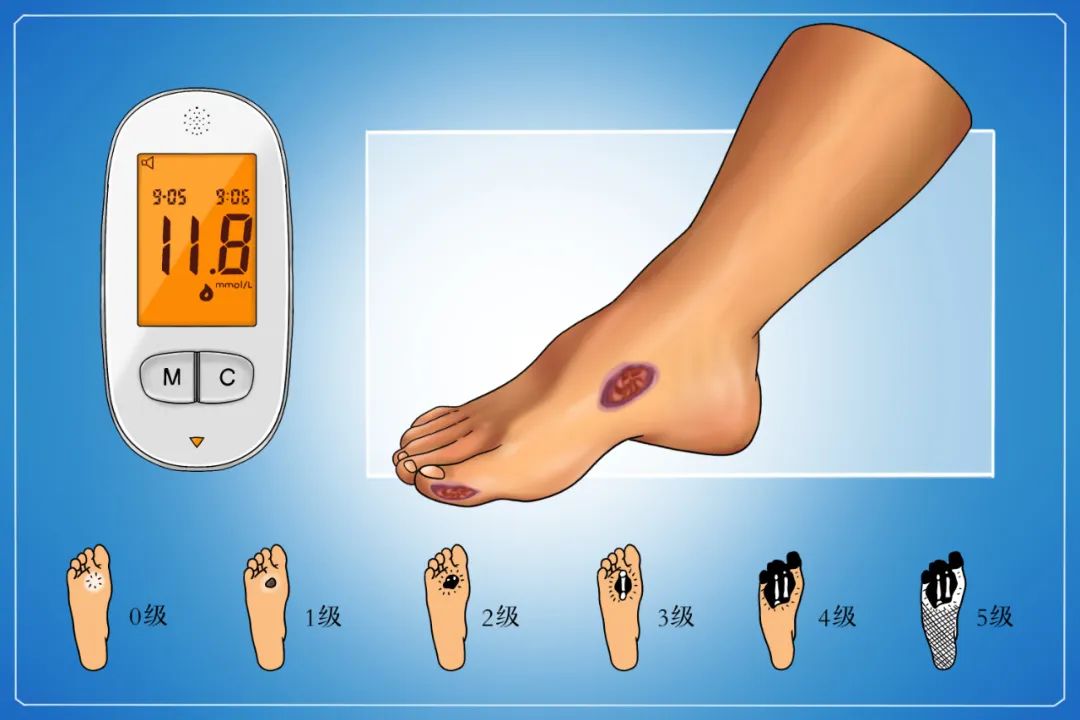
With the development of economic level and the change of diet structure, the incidence of diabetes is increasing globally, and various complications caused by diabetes will also follow. Among them, diabetic foot is one of the complications that seriously affect patients' quality of life. According to the 2019 edition of China's Diabetic Foot Prevention and Treatment guidelines, there is a case of amputation of diabetic foot every 20 seconds in the world, and the incidence of diabetic foot in diabetic patients over 50 years old in China is about 8.1%.
What is diabetic foot?

Diabetic foot is a kind of peripheral nerve and vascular disease involving nerves, blood vessels, skin, tendons, and even bones, and is also one of the main causes of disability and death in diabetic patients. Diabetic foot is prone to recurrence and infection, and its treatment has always been a difficult problem in clinical practice. Traditional treatment usually requires patients to be hospitalized several times, and the disease can be controlled by a series of combined treatment methods such as debridement, dressing change, blood sugar control and antibiotics. Repeated treatment not only aggravates the pain of the patient, but also brings a heavy financial burden to the family. Statistical studies have shown that even after these treatments, 25% of patients are still at risk of amputation.
Therefore, diabetic patients urgently need a once-and-for all method to cure diabetic foot and preserve the affected limb as much as possible. In recent years, with the development of life medicine technology, stem cells and related derivatives have made remarkable achievements in the clinical application of diabetic foot, providing a new treatment option for patients.
Why does diabetic foot occur?
If you want to treat diabetic foot, you must first understand how it happens, and only by solving the problem from the source can you achieve the purpose of cure. The pathophysiological mechanism of diabetic foot is mainly related to the injury and proliferation of capillary endothelial cells in patients.
1. Patients with diabetes may abnormally activate certain metabolic pathways due to persistent hyperglycemia, which leads to insufficient blood supply and oxygen supply to the lower extremity terminal vessels. The lower extremity is an important weight-bearing part of the body, and there are often inducements such as friction and exposure, coupled with the numbness of patients with neurological diseases, so it is easy to form ulcers.
2, the high blood sugar state of diabetes patients is a good nutrient base of bacteria, so it is easy to co-infection. In addition, the immune regulatory mechanism of such patients is abnormal, so the healing speed of ulcers is slow.
How can Stem cells treat diabetic foot?
1. Mechanism of stem cell therapy for diabetic foot
Mesenchymal stem cells have the functions of self-replication, self-renewal, multidirectional differentiation and secretion, immune regulation, promoting tissue angiogenesis and so on. Relevant studies have found that mesenchymal stem cells can gather around wounds and differentiate into keratinocytes, endothelial cells and other skin cells, so as to promote wound healing.
2. Types of stem cell applications
At present, in clinical and clinical studies, stem cells used to treat diabetic foot mainly include adipose mesenchymal stem cells, bone marrow mesenchymal stem cells, umbilical cord mesenchymal stem cells, placental mesenchymal stem cells, umbilical cord blood mesenchymal stem cells, etc. Among them, adipose mesenchymal stem cells have the advantages of easy access, wide source and strong self-differentiation ability, which can promote wound healing, and are ideal treatment methods for diabetic foot ulcer wound patients, and are also widely used at present.
3. Route of administration of stem cell therapy
When stem cell therapy is used to treat diabetic foot, the common administration routes include the following: local topical application, subcutaneous injection, intradermal injection, intramuscular injection, and partial injection for ulcers.
Future outlook
In the treatment of diabetes, stem cells can not only promote the healing of ulcer wounds, but also be induced to become insulin secreting cells. With the lack of in-depth stem cell research, if it can be comprehensively promoted in clinical practice in the future, it can not only treat serious complications such as diabetic foot, but also help improve the islet function of diabetic patients, so that they can get rid of dependence on exogenous insulin. However, as an emerging technology, stem cell therapy still has a long way to go at this stage.